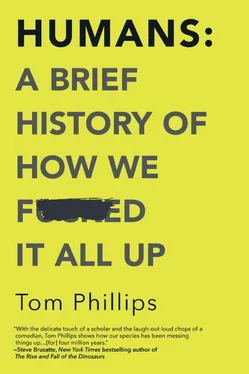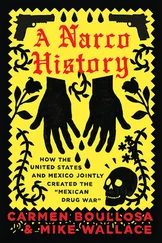Tom Phillips - Humans - A Brief History of How We F*cked It All Up
Здесь есть возможность читать онлайн «Tom Phillips - Humans - A Brief History of How We F*cked It All Up» весь текст электронной книги совершенно бесплатно (целиком полную версию без сокращений). В некоторых случаях можно слушать аудио, скачать через торрент в формате fb2 и присутствует краткое содержание. Город: Toronto, Год выпуска: 2019, ISBN: 2019, Издательство: Hanover Square Press, Жанр: История, Юмористические книги, на английском языке. Описание произведения, (предисловие) а так же отзывы посетителей доступны на портале библиотеки ЛибКат.
- Название:Humans: A Brief History of How We F*cked It All Up
- Автор:
- Издательство:Hanover Square Press
- Жанр:
- Год:2019
- Город:Toronto
- ISBN:978-1-48805-113-5
- Рейтинг книги:4 / 5. Голосов: 1
-
Избранное:Добавить в избранное
- Отзывы:
-
Ваша оценка:
- 80
- 1
- 2
- 3
- 4
- 5
Humans: A Brief History of How We F*cked It All Up: краткое содержание, описание и аннотация
Предлагаем к чтению аннотацию, описание, краткое содержание или предисловие (зависит от того, что написал сам автор книги «Humans: A Brief History of How We F*cked It All Up»). Если вы не нашли необходимую информацию о книге — напишите в комментариях, мы постараемся отыскать её.
Humans: A Brief History of How We F*cked It All Up — читать онлайн бесплатно полную книгу (весь текст) целиком
Ниже представлен текст книги, разбитый по страницам. Система сохранения места последней прочитанной страницы, позволяет с удобством читать онлайн бесплатно книгу «Humans: A Brief History of How We F*cked It All Up», без необходимости каждый раз заново искать на чём Вы остановились. Поставьте закладку, и сможете в любой момент перейти на страницу, на которой закончили чтение.
Интервал:
Закладка:
Eugene Schieffelin made basically the same mistake as Chairman Mao, except in the opposite direction. And where Mao’s error was driven by a combination of public health goals and dictatorial fiat, the havoc that Schieffelin caused in his ecosystem—a man-made natural disaster that continues to this day—was driven entirely by whimsy.
What Schieffelin did one cold early spring day in 1890 has ended up spreading disease, destroying hundreds of millions of dollars’ worth of crops every year and even killed 62 people in a plane crash. Which is quite a lot of damage for someone who was just trying to show off what a huge fan of Shakespeare he was.
Schieffelin was a well-to-do drug manufacturer who lived in New York City, but despite the strong potential for damaging screw-ups in that line of work, his contribution to environmental chaos stems not from his profession, but rather from his hobbies. He was extremely keen on two fashionable trends of the age—an absolute devotion to the works of Shakespeare, and transplanting species into new habitats.
At the time, Western culture was going through an all-consuming Shakespeare revival, with the result that the Bard had attained a status in popular culture that was at roughly Beyoncé levels. Meanwhile, based on a French idea, groups called “acclimatization societies” had started spreading around the Western world—voluntary groups of wealthy do-gooders who devoted themselves to introducing foreign species of plants and animals to their countries. (This was many years before people would twig just what an awful idea that could be.)
Schieffelin’s mistake stemmed from the fact that he was the chairman of the American Acclimatization Society, based in New York, and also that he absolutely bloody loved Shakespeare. And so he hit on a delightful, eccentric plan: what better way to honor the greatest poet in the English language, he thought, than to introduce every single species of bird mentioned in Shakespeare’s plays to the USA? The American Acclimatization Society set to work.
At first, they ran up against a string of failures: birds such as skylarks, bullfinches and song thrushes were released into the wild (well, the city, at least) but failed to take hold, dying out after a few years in the unfamiliar environment. But then, on March 6, 1890, Eugene Schieffelin stood in Central Park with his assistants and began opening a number of cages that contained a total of 60 European starlings.
You can’t really blame Shakespeare for all this, but if he’d chosen a different bit of hyperbole in Act I, Scene III of Henry IV, Part I , then things would have been very different. In that scene, the character Hotspur, describing his determination to keep pressure on the king to pay a ransom for his brother-in-law Mortimer (despite the king forbidding him to even mention Mortimer’s name), says:
Nay,
I’ll have a starling shall be taught to speak
Nothing but “Mortimer,” and give it him
To keep his anger still in motion.
That’s the only time Shakespeare ever mentions starlings. The whole of the rest of the complete works, not a dicky bird. But that single reference was enough for our Eugene.
Those initial 60 starlings were released in 1890, and in 1891 Schieffelin went back and released 40 more. Initially, it didn’t look great for the first American starlings—within a few years of bitter New York winters, only 32 of the original hundred were still alive, and it looked like they might follow in the wingbeats of their unlucky predecessors. But starlings are tough, versatile creatures, adept at fitting into new environments and bullying their way to survival. In an impressive bit of irony, a small flock of them found shelter from the elements under the eaves of the American Museum of Natural History—a building dedicated to preserving the nation’s natural history inadvertently helped to alter that history dramatically. Because gradually, the starlings’ numbers began to grow. And grow. And grow.
Before the decade was out, they were common across New York City. By the 1920s, they’d spread halfway across the country. By the 1950s, they were in California. Today, there are 200 million of the buggers living all across North America, and you can find them everywhere from Mexico to Alaska.
They have become, in the words of the New York Times , “one of the costliest and most noxious birds on our continent”—or, as the Washington Post once described them, “arguably the most hated bird in North America.” Flocking together in huge murmurations that can number up to a million birds, they destroy crops on a vast scale, tearing through wheat fields and potato fields alike and obliterating grain stores. They are aggressive, chasing native bird species out of their nests, and they help spread diseases that affect both humans and livestock, from fungal infections to salmonella. They shit absolutely everywhere, and it smells awful.
Their massive flocks also pose a danger to air travel—in Boston in 1960, an estimated 10,000 starlings flew into a plane as it took off from Logan Airport, destroying its engines and sending it crashing to the ground, where 62 of the 72 passengers on board died.
Starlings are a pest, a health hazard and a significant financial drain on the agricultural economy of North America. The only reason they’re even present on the continent is because a nice upper-middle-class chap was way too into his hobbies and didn’t stop to think about the potential consequences. If he’d got into jogging or home-brewing or watercolors instead, none of this would have happened.
On the plus side, I guess, they probably help keep the insect population down?
Everybody loves cats. Except in New Zealand, which didn’t have any predatory mammals until we brought them with us—which was bad news for the local species, particularly the plump, flightless parrot the kakapo.
Like the rabbits, cane toads (natives of South America) were introduced into Australia with good intentions—in this case, to eat a pest, cane beetles. They didn’t eat the cane beetles. They ate almost everything else, though.
When the American gray squirrel was introduced to Britain and Ireland, it immediately started throwing its weight around and bullying the native red squirrel close to extinction.
A particularly annoying and potentially disease-spreading mosquito (it feeds at all hours, unlike many other species), it’s notable for how it hopped continents—it traveled from Japan to America in 1985 in a shipment of used tires.
Look, if you’re going to introduce an Asian species into America, maybe don’t make it a ravenous carnivorous fish that can walk across land and survive for days out of water? That’s just asking for trouble.
4
Follow the Leader
As human societies grew more complex, with villages becoming towns becoming cities, we were forced to confront a problem that’s common to any large group faced with a complicated task—whether that’s founding a civilization or working out where to go for dinner. Ultimately, you need someone to make a decision.
We don’t know much about how the earliest human societies organized themselves. Human nature being what it is, it’s a good bet that there have always been people who liked bossing other people around, but it’s not entirely clear when this became an actual job rather than just a hobby.
Читать дальшеИнтервал:
Закладка:
Похожие книги на «Humans: A Brief History of How We F*cked It All Up»
Представляем Вашему вниманию похожие книги на «Humans: A Brief History of How We F*cked It All Up» списком для выбора. Мы отобрали схожую по названию и смыслу литературу в надежде предоставить читателям больше вариантов отыскать новые, интересные, ещё непрочитанные произведения.
Обсуждение, отзывы о книге «Humans: A Brief History of How We F*cked It All Up» и просто собственные мнения читателей. Оставьте ваши комментарии, напишите, что Вы думаете о произведении, его смысле или главных героях. Укажите что конкретно понравилось, а что нет, и почему Вы так считаете.












